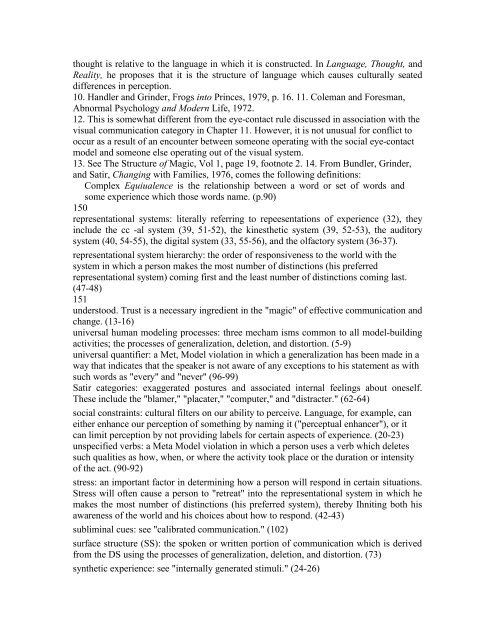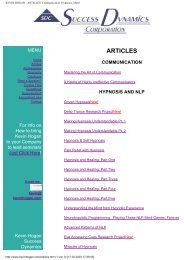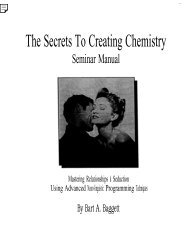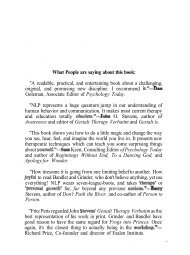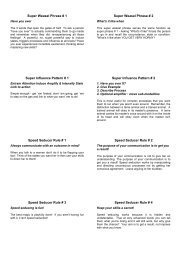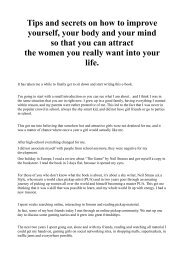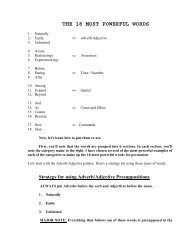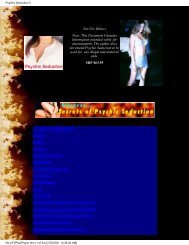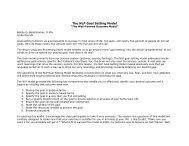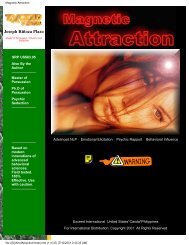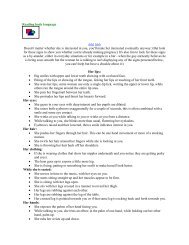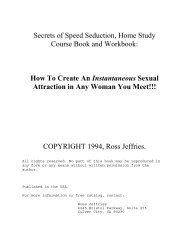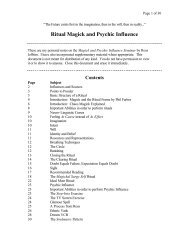A Pragmatic Guide To Communication & Change.pdf - NLP Info Centre
A Pragmatic Guide To Communication & Change.pdf - NLP Info Centre
A Pragmatic Guide To Communication & Change.pdf - NLP Info Centre
- No tags were found...
You also want an ePaper? Increase the reach of your titles
YUMPU automatically turns print PDFs into web optimized ePapers that Google loves.
thought is relative to the language in which it is constructed. In Language, Thought, and<br />
Reality, he proposes that it is the structure of language which causes culturally seated<br />
differences in perception.<br />
10. Handler and Grinder, Frogs into Princes, 1979, p. 16. 11. Coleman and Foresman,<br />
Abnormal Psychology and Modern Life, 1972.<br />
12. This is somewhat different from the eye-contact rule discussed in association with the<br />
visual communication category in Chapter 11. However, it is not unusual for conflict to<br />
occur as a result of an encounter between someone operating with the social eye-contact<br />
model and someone else operating out of the visual system.<br />
13. See The Structure of Magic, Vol 1, page 19, footnote 2. 14. From Bundler, Grinder,<br />
and Satir, Changing with Families, 1976, comes the following definitions:<br />
Complex Equiualence is the relationship between a word or set of words and<br />
some experience which those words name. (p.90)<br />
150<br />
representational systems: literally referring to repeesentations of experience (32), they<br />
include the cc -al system (39, 51-52), the kinesthetic system (39, 52-53), the auditory<br />
system (40, 54-55), the digital system (33, 55-56), and the olfactory system (36-37).<br />
representational system hierarchy: the order of responsiveness to the world with the<br />
system in which a person makes the most number of distinctions (his preferred<br />
representational system) coming first and the least number of distinctions coming last.<br />
(47-48)<br />
151<br />
understood. Trust is a necessary ingredient in the "magic" of effective communication and<br />
change. (13-16)<br />
universal human modeling processes: three mecham isms common to all model-building<br />
activities; the processes of generalization, deletion, and distortion. (5-9)<br />
universal quantifier: a Met, Model violation in which a generalization has been made in a<br />
way that indicates that the speaker is not aware of any exceptions to his statement as with<br />
such words as "every" and "never" (96-99)<br />
Satir categories: exaggerated postures and associated internal feelings about oneself.<br />
These include the "blamer," "placater," "computer," and "distracter." (62-64)<br />
social constraints: cultural filters on our ability to perceive. Language, for example, can<br />
either enhance our perception of something by naming it ("perceptual enhancer"), or it<br />
can limit perception by not providing labels for certain aspects of experience. (20-23)<br />
unspecified verbs: a Meta Model violation in which a person uses a verb which deletes<br />
such qualities as how, when, or where the activity took place or the duration or intensity<br />
of the act. (90-92)<br />
stress: an important factor in determining how a person will respond in certain situations.<br />
Stress will often cause a person to "retreat" into the representational system in which he<br />
makes the most number of distinctions (his preferred system), thereby Ihniting both his<br />
awareness of the world and his choices about how to respond. (42-43)<br />
subliminal cues: see "calibrated communication." (102)<br />
surface structure (SS): the spoken or written portion of communication which is derived<br />
from the DS using the processes of generalization, deletion, and distortion. (73)<br />
synthetic experience: see "internally generated stimuli." (24-26)


